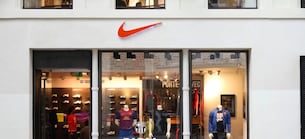Nike vs. Lululemon: Is Either Apparel Stock Due for a Sharp Rebound?
Werte in diesem Artikel
It’s been almost a week since Lululemon’s LULU lackluster Q2 report led to a sharp decline in its stock, hitting a new 52-week low of $162 a share. Although Lululemon was able to exceed Q2 earnings expectations, the leading athletic apparel company slashed its full-year guidance, with a major factor being a $240 million hit from tariffs.This has raised concerns about the effects of a challenging macro environment on other active-wear apparel companies, including Nike NKE, which is scheduled to report results for its fiscal first quarter on Tuesday, September 30. Like Lululemon, Nike's stock has been submerged in volatility, climbing off a one-year low of $52 a share but still 19% from a 52-week peak of $90. Furthermore, NKE is more than 50% below its all-time high of $167, with LULU trading 67% beneath its record peaks of $511.Despite their grizzly stock performances in recent years, let’s see if now is an opportune time to invest in either of these leading apparel retailers for a sharp rebound.Image Source: Zacks Investment Research Stale Product Lines & Lululemon’s Surprising Competitors Offering high-quality activewear and footwear, both brands compete directly in the athletic apparel market, but Lululemon has faced increased competition from unlikely competitors that appear to be disrupting its core business. Simarlar to Nike, Lululemon’s management has admitted that its product lines have become stale and is racing to fast-track new designs. Centered around its yoga-inspired athleisure gear, Lululemon’s same-store sales fell 4% during Q2 in its core North American market. Notably, several analysts and CNBC contributor Jim Cramer pointed to surprising scenarios/competitors for the disruption, such as more affordable jogger brands offered by Costco COST and The Gap GAP.While it wasn’t enough to offset domestic concerns, Lululemon's international sales surged last quarter, with China segment sales up 25% and collective markets in the rest of the world up 19%. Still, Lululemon is being impacted by the removal of the de minimis exemption, which previously allowed smaller international shipments to bypass tariff duties. Raising more fears regarding margin pressures and its stale product line, Lululemon’s inventory ballooned 21% year over year to $1.7 billion.Image Source: Zacks Investment Research Nike’s Leadership Overhaul & Strategic PivotFacing a growing number of competitors outside of Adidas ADDYY, Nike has undergone a leadership change with long-term executive Elliott Hill taking over as President and CEO in 2024. Having more than 30 years of experience with Nike, Hill has refocused the iconic sports brand on its core strengths after a tech-centric strategy misfired.Pouring resources into digital ads and performance marketing, Nike still experienced a drop-off in digital sales and alienated partners like Foot Locker and Macy’s M in a bid to boost its direct-to-consumer (DTC) reach on Nike.com. It’s noteworthy that Nike’s inventory remained flat during its most recent fiscal fourth quarter, and expects to have a “clean” inventory position by the first half of its current fiscal year 2026.Aiming to rebuild relationships with third-party vendors, Hill has refocused Nike on wholesale distribution, product innovation, and storytelling campaigns. Plus, Nike has announced plans to shift manufacturing away from China, aiming to reduce exposure to tariffs that could cost up to $1 billion. Stating that the brunt of the tariff impact may be behind it, Nike’s leadership has implemented a four-pronged plan that also includes negotiating with suppliers and retailers to share the cost burden, while cutting corporate costs and selectively raising prices in the U.S. Nike is better suited to handle Tarriff headwindsWhile Lululemon’s immense profitability has wowed investors at times, it doesn’t take Captain Obvious to realize that Nike may be better suited to handle tariff headwinds. Even with Nike facing higher tariff costs, the company is projected to bring in over $40 billion in annual sales for the foreseeable future, compared to Lululemon’s forecast of $11 billion or more.That said, Nike is generally better positioned to handle tariffs than Lululemon thanks to its supply chain maturity as well. Having a deeper global infrastructure, Nike has diversified manufacturing from multiple countries outside of China, including Vietnam, Indonesia, and India. Lululemon, on the other hand, is more vulnerable to sudden policy shifts and cost spikes as it relies heavily on Canadian and Vietnamese factories.Image Source: Zacks Investment Research Conclusion & Final ThoughtsBeing further along in its turnaround strategy, a rebound looks more likely for Nike stock, as there could still be more short-term weakness ahead for Lululemon shares. Of course, Lululemon will need to overcome tariff uncertainties, but one thing it can learn from Nike as it undergoes an apparel renovation of its own, is that tech is not always a substitute for product relevance, retail relationships, or emotional brand storytelling that resonates with consumers.Quantum Computing Stocks Set To SoarArtificial intelligence has already reshaped the investment landscape, and its convergence with quantum computing could lead to the most significant wealth-building opportunities of our time.Today, you have a chance to position your portfolio at the forefront of this technological revolution. In our urgent special report, Beyond AI: The Quantum Leap in Computing Power, you'll discover the little-known stocks we believe will win the quantum computing race and deliver massive gains to early investors.Access the Report Free Now >>Want the latest recommendations from Zacks Investment Research? Today, you can download 7 Best Stocks for the Next 30 Days. Click to get this free report NIKE, Inc. (NKE): Free Stock Analysis Report lululemon athletica inc. (LULU): Free Stock Analysis Report Macy's, Inc. (M): Free Stock Analysis Report Costco Wholesale Corporation (COST): Free Stock Analysis Report The Gap, Inc. (GAP): Free Stock Analysis Report Adidas AG (ADDYY): Free Stock Analysis ReportThis article originally published on Zacks Investment Research (zacks.com).Zacks Investment ResearchWeiter zum vollständigen Artikel bei Zacks
Übrigens: Nike und andere US-Aktien sind bei finanzen.net ZERO sogar bis 23 Uhr handelbar (ohne Ordergebühren, zzgl. Spreads). Jetzt kostenlos Depot eröffnen und Neukunden-Bonus sichern!
Ausgewählte Hebelprodukte auf Nike
Mit Knock-outs können spekulative Anleger überproportional an Kursbewegungen partizipieren. Wählen Sie einfach den gewünschten Hebel und wir zeigen Ihnen passende Open-End Produkte auf Nike
Der Hebel muss zwischen 2 und 20 liegen
| Name | Hebel | KO | Emittent |
|---|
| Name | Hebel | KO | Emittent |
|---|
Quelle: Zacks
Nachrichten zu Nike Inc.
Analysen zu Nike Inc.
| Datum | Rating | Analyst | |
|---|---|---|---|
| 13.10.2025 | Nike Outperform | Bernstein Research | |
| 10.10.2025 | Nike Outperform | RBC Capital Markets | |
| 02.10.2025 | Nike Buy | Goldman Sachs Group Inc. | |
| 02.10.2025 | Nike Hold | Joh. Berenberg, Gossler & Co. KG (Berenberg Bank) | |
| 01.10.2025 | Nike Outperform | Bernstein Research |
| Datum | Rating | Analyst | |
|---|---|---|---|
| 13.10.2025 | Nike Outperform | Bernstein Research | |
| 10.10.2025 | Nike Outperform | RBC Capital Markets | |
| 02.10.2025 | Nike Buy | Goldman Sachs Group Inc. | |
| 01.10.2025 | Nike Outperform | Bernstein Research | |
| 01.10.2025 | Nike Kaufen | DZ BANK |
| Datum | Rating | Analyst | |
|---|---|---|---|
| 02.10.2025 | Nike Hold | Joh. Berenberg, Gossler & Co. KG (Berenberg Bank) | |
| 01.10.2025 | Nike Neutral | UBS AG | |
| 01.10.2025 | Nike Equal Weight | Barclays Capital | |
| 29.09.2025 | Nike Neutral | UBS AG | |
| 04.09.2025 | Nike Sector Perform | RBC Capital Markets |
| Datum | Rating | Analyst | |
|---|---|---|---|
| 22.08.2023 | Nike Verkaufen | DZ BANK | |
| 30.06.2023 | Nike Verkaufen | DZ BANK | |
| 14.06.2022 | Nike Hold | HSBC | |
| 25.06.2021 | Nike Verkaufen | DZ BANK | |
| 23.04.2021 | Nike Verkaufen | DZ BANK |
Um die Übersicht zu verbessern, haben Sie die Möglichkeit, die Analysen für Nike Inc. nach folgenden Kriterien zu filtern.
Alle: Alle Empfehlungen


